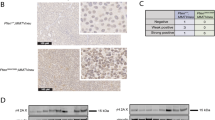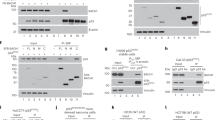Abstract
Bcl-2 can both promote and attenuate tumorigenesis. Although the former function is relatively well characterized, the mechanism of the latter remains elusive. We report here that enforced Bcl-2 expression in MCF7 cells stabilizes p53, induces phosphorylation of p53 serine 15 (p53pSer15) and inhibits MCF7 cell growth. Consistent with p53 Ser15 being a target of ataxia telangiectasia mutated protein(ATM)/ATR (ATM- and rad3-related) in the DNA damage response, Bcl-2 activates ATM by inducing ATM Ser1981 phosphorylation, which is accompanied with the phosphorylaton of two additional ATM substrates, Chk2 Thr68 and H2AX Ser139. Downregulation of ATM using a specific small interference RNA fragment (ATMRNAi) abolished Bcl-2-induced p53pSer15 and Bcl-2-mediated growth inhibition of MCF7 cells. Ectopic expression of a dominant-negative p53 mutant, p53175H, partially rescued this growth inhibition. Taken together, these observations demonstrate the contribution of ATM-p53 function to Bcl-2-mediated inhibition of MCF7 cell growth, indicating an ATM-mediated surveillance system for regulating Bcl-2 overexpression. Consistent with this concept, we found that MCF7 cells express Bcl-2 heterogeneously with 34.5% of cells being Bcl-2 negative. In general, Bcl-2-positive MCF7 cells proliferate slower than those of Bcl-2 negative. Thus, we provide evidence suggesting that activation of ATM suppresses Bcl-2-induced tumorigenesis, and that attenuation of ATM function may be an important event in breast cancer progression.
This is a preview of subscription content, access via your institution
Access options
Subscribe to this journal
Receive 50 print issues and online access
$259.00 per year
only $5.18 per issue
Buy this article
- Purchase on Springer Link
- Instant access to full article PDF
Prices may be subject to local taxes which are calculated during checkout







Similar content being viewed by others
References
Bakhshi A, Jensen JP, Goldman P, Wright JJ, McBride OW, Epstein AL et al. (1985). Cell 41: 899–906.
Bakkenist CJ, Kastan MB . (2003). Nature 421: 499–506.
Bartkova J, Horejsi Z, Koed K, Kramer A, Tort F, Zieger K et al. (2005). Nature 434: 864–870.
Brady HJM, Gil-Gonez G, Kirberg J, Berns JM . (1996). EMBO J 15: 6991–7001.
Chang J, Clark GM, Allred DC, Mohsin S, Chamness G, Elledge RM . (2003). Cancer 97: 545–553.
Charpin C, Garcia S, Bonnier P, Martini F, Andrac L, Horschowski N et al. (1998). J Clin Oncol 16: 2025–2031.
Cleary ML, Smith SD, Sklar J . (1986). Cell 47: 19–28.
Cong F, Zou X, Hinrichs K, Calame K, Goff SP . (1999). Oncogene 18: 7731–7739.
Daidone MG, Luisi A, Veneroni S, Benini E, Silvestrini R . (1999). Endocr Relat Cancer 6: 61–68.
Damalas A, Ben-Ze'ev A, Simcha I, Shtutman M, Leal JFM, Zhurinsky J et al. (1999). EMBO J 18: 3054–3063.
Damalas A, Kahan S, Shtutman M, Ben Ze'ev A, Oren M . (2001). EMBO J 20: 4912–4922.
de La Coste A, Mignon A, Fabre M, Gilbert E, Porteu A, Van Dyke T et al. (1999). Cancer Res 59: 5017–5022.
de Stanchina E, McCurrach ME, Zindy F, Shieh SY, Ferbeyre G, Samuelson AV et al. (1998). Genes Dev 12: 2434–2442.
Dimri GP, Itahana K, Acosta M, Campisi J . (2000). Mol Cell Biol 20: 273–285.
DiTullio Jr RA, Mochan TA, Venere M, Bartkova J, Sehested M, Bartek J et al. (2002). Nat Cell Biol 4: 998–1002.
Gee JM, Robertson JF, Ellis IO, Willsher P, McClelland RA, Hoyle HB et al. (1994). Int J Cancer 59: 619–628.
Gorgoulis VG, Vassiliou LV, Karakaidos P, Zacharatos P, Kotsinas A, Liloglou T et al. (2005). Nature 434: 907–913.
Hellemans P, van Dam PA, Weyler J, van Oosterom AT, Buytaert P, Van Marck E . (1995). Br J Cancer 72: 354–360.
Huang DCS, O'Reilly LA, Strasser A, Cory S . (1997). EMBO J 15: 4628–4638.
Jager JJ, Jansen RLH, Arends JW . (2002). Apoptosis 7: 361–365.
Joensuu H, Pylkkanen L, Toikkanen S . (1994). Am J Pathol 145: 1191–1198.
Kharbanda S, Pander P, Schofield L, Israels S, Roncinske R, Yoshida K et al. (1997). Proc Natl Acad Sci USA 94: 6939–6942.
Kirkin V, Joos S, Zornig M . (2004). Biochem Biophys Acta 1644: 229–249.
Kluck RM, Bossy-Wetzel E, Green DR, Newmeyer DD . (1997). Science 275: 1132–1136.
Ko LJ, Prives C . (1996). Genes Dev 10: 1054–1072.
Le MG, Mathieu MC, Douc-Rasy S, Le Bihan ML, Adb El All H, Spielmann M et al. (1999). Int J Cancer 84: 562–567.
Lee JH, Paull TT . (2004). Science 304: 93–96.
Li Y, Wu D, Chen B, Ingram A, He L, Liu L et al. (2004). Oncogene 23: 7355–7365.
Linette GP, Li Y, Roth K, Korsmeyer SJ . (1996). Proc Natl Acad Sci USA 93: 9545–9552.
Lipponen P, Pietilainen T, Kosma VM, Aaltomaa S, Eskelinen M, Syrjanen K . (1995). J Pathol 177: 49–55.
Mazel S, Burtrum D, Petrie HT . (1996). J Exp Med 183: 2219–2226.
Murphy KL, Kittrell FS, Gay JP, Jager R, Medina D, Rosen JM . (1999). Oncogene 18: 6597–6604.
O'Reilly LA, Huang DCS, Strasser A . (1996). EMBO J 15: 6979–6990.
Palmero I, Pantoja C, Serrano M . (1998). Nature 395: 125–126.
Paull TT, Rogakou EP, Yamazaki V, Kirchgessner CU, Gellert M, Bonner WM . (2000). Curr Biol 10: 886–895.
Pietenpol JA, Papadopoulos N, Markowitz S, Willson JKV, Kinzler KW, Vogelstein B . (1994). Can Res 54: 3714–3717.
Saintigny Y, Dumay A, Lambert S, Lopez BS . (2001). EMBO J 20: 2596–2607.
Scorrano L, Oakes SA, Opferman JT, Cheng EH, Sorcinelli MD, Pozzan T et al. (2003). Science 300: 135–139.
Serrano M, Lin AW, McCurrach ME, Beach D, Lowe SW . (1997). Cell 88: 593–602.
Shiloh Y . (2003). Nat Rev Cancer 3: 155–168.
Silvestrini R, Veneroni S, Daidone MG, Benini E, Boracchi P, Mezzetti M et al. (1994). J Natl Cancer Inst 86: 499–504.
Tang D, Wu D, Hirao A, Lahti JM, Liu L, Mazza B et al. (2002). J Biol Chem 277: 12710–12717.
Tsunimoto Y, Finger LR, Uyinis J, Nowell PC, Croce CM . (1984). Science 266: 1097–1099.
Vairo G, Innes KM, Adams JM . (1996). Oncogene 13: 1511–1519.
van Slooten HJ, Clahsen PC, van Dierendonck JH, Duval C, Pallud C, Mandard AM et al. (1996). Br J Cancer 74: 78–85.
Yang J, Lie X, Bhalla K, Kim CN, Ibrado AM, Car J et al. (1997). Science 275: 1129–1132.
Youn CK, Cho HJ, Kim SH, Kim HB, Kim MH, Chang IY et al. (2005). Nat Cell Biol 7: 137–147.
Zindy F, Eischen CM, Randle DH, Kamijo T, Cleveland JL, Sherr CJ et al. (1998). Genes Dev 12: 2424–2433.
Acknowledgements
This work was supported by a CIHR Grant to D Tang. NIH Grant CA67938 to JMl/VJK and NIH Cancer Center Support Grant to St Jude Children's Research Hospital and support from ALSAC (American Syrian Lebanese Associated Charities) to JML/VJK. We are very grateful to Dr Tei Wei for his assistance.
Author information
Authors and Affiliations
Corresponding authors
Rights and permissions
About this article
Cite this article
Zhang, J., Lahti, J., Bruce, A. et al. Identification of an ataxia telangiectasia-mutated protein mediated surveillance system to regulate Bcl-2 overexpression. Oncogene 25, 5601–5611 (2006). https://doi.org/10.1038/sj.onc.1209565
Received:
Revised:
Accepted:
Published:
Issue Date:
DOI: https://doi.org/10.1038/sj.onc.1209565
Keywords
This article is cited by
-
The stem cell factor antibody enhances the chemotherapeutic effect of adriamycin on chemoresistant breast cancer cells
Cancer Cell International (2012)



